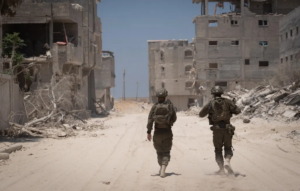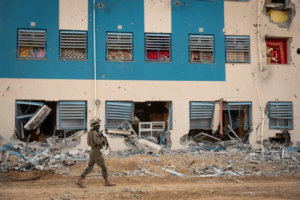‘Army of militias’: Reservist’s explosive book on Gaza exposes Israel’s war machine from within

Israeli soldiers in Gaza.
Ronen Tal writes in Haaretz on 30 January 2025:
It’s early evening in a destroyed mosque after an Israeli bombing. The floor is littered with plaster from the ceiling, the windows have been blown out, the chairs turned into pieces of wood. Gazan men, their hands bound behind them, are sitting on the floor in rows, waiting for their turn to be interrogated. An Israeli soldier with a rifle is standing in front of them and tearing pages out of a Quran.
“I approached him and asked him for the meaning of his behavior,” Asaf Hazani writes in his Hebrew-language book One Way or Another the Sword Shall Devour – Anthropology in War: A Field Diary. “He replied with a sad look, really the saddest look imaginable. ‘Me? I’m taking revenge against them.'”
This is a rare instance where the author of a current-affairs book refuses to go through with the interview that he himself initiated, because his commanders dissented. The image of the sad soldier tearing out the pages of the book so sacred to Muslims lingers through Lt. Col. Hazani’s work, which is based on the author’s war diary. Hazani is an anthropologist who did reserve duty as a staff officer for a combat division in Gaza. The tearing up of the Quran was a violation of army norms, but Hazani eschews ethical judgments and tries to uncover the unconscious emotional motivation that caused this gratuitous rite of desecration.
“That soldier was deep inside a private ritual of his own, almost in a trance. It’s hard to convey in a text the extent to which this activity lacked any logical meaning,” Hazani writes. “Those Qurans were already destroyed. Most of the pages were already torn . … He only tore them even more. … But he didn’t want to leave any trace of them. … He felt that revenge was definitely a legitimate emotion at that stage of the fighting – a more legitimate emotion than depression, shock or exhaustion.”
The story also reveals the ethos of revenge in the war among both soldiers and commanders – an ethos that has seeped into the media’s coverage. It erupted in a variety of ways and has often been documented by the soldiers themselves on social media, an unfortunate choice that got the attention of the International Criminal Court in The Hague and even harried a few soldiers who were traveling abroad.
Another expression of this ethos is combat units’ torching of areas in the Gaza Strip without any operational need. “There were fires that actually undermined our ability to carry out professional missions,” Hazani writes. “Others were started in an attempt to achieve goals beyond the current mission, whether it was simple revenge or the destruction of infrastructure that could be used to rebuild the area in the future. [These fires] weren’t included in our stated goals, even if after the fact someone fabricated justification for the arson.”
And as with the soldier in the mosque, the gratuitous acts of arson weren’t a result of uncontrollable passions in the heat of battle. “None of these activities were carried out in a sacred fury of revenge or with poison in their eyes; they happened more in a trio of grief, sadness and fatigue,” Hazani writes.
‘The families and the groups’
One Way or Another the Sword Shall Devour combines the author’s personal experiences and his critical analysis using anthropological tools, which sometimes take you to theoretical realms not easily decipherable if you don’t know the jargon.

Asaf Hazani
Hazani drops the names of philosophers like Gilles Deleuze and Felix Guattari, and scholars such as Don Handelman and Clifford Geertz, with Franz Kafka, Haruki Murakami and Susan Sontag thrown in. Hazani doesn’t question the decision to embark on the war, and he makes sure not to reveal operational details (the book went through the military censor). He also skips over the debate that has torn Israeli society apart: whether it’s right to end the fighting in order to free the hostages.
But that heavy cloud of “grief, sadness and fatigue” pervades the book; it blends with the feeling that many Israelis have: Despite the achievements on the battlefield, the war has ended in defeat.
About a month ago, Asaf Carmel, the publisher’s PR consultant, proposed to Haaretz’s literary supplement an interview with Hazani. Carmel said that because the author was a civilian employee of the Israel Defense Forces, and his book was based on reserve duty in wartime, the interview needed the army’s approval. The approval was given, but a few hours later it was canceled. The IDF Spokesperson’s Unit said Hazani’s commanders had reservations, and soon they would be talking with him. They did talk to him, and Hazani decided not to be interviewed by the media. The reason, on top of vague fears whose details are unclear, was not given.
Hazani’s book can be found in every branch of Steimatzky and Tzomet Sfarim, Israel’s two main bookstore chains. And copies have been sent to journalists, book reviewers and defense researchers. But this is a rare instance where the author of a current-affairs book refuses to go through with the interview that he himself initiated, because his commanders dissented.
This triggers worries about self-censorship. It’s hard not to wonder what the senior officers are afraid of. What embarrassing information that Hazani kept out of his book is he likely to blurt out in a newspaper interview? (The IDF Spokesman’s Unit said: “Hazani had second thoughts and decided not to be interviewed. As far as we are concerned, there is no reason he should not be interviewed.”)
Hazani explains that firing in response to an undefined threat is a recipe for mishaps such as friendly fire, ‘but apparently the group of officers from the other division weren’t concerned about the danger of friendly fire.’
Hazani is the head of war games at the Dado Center for Interdisciplinary Military Studies, part of the General Staff’s Operations Directorate. For his doctoral thesis at the Hebrew University of Jerusalem, he explored the interface between technology and space. Hazani has written a raft of articles on military subjects and two books. Azazel Canyon documents two years of jeep tours in the Judean Desert, and Murder in Area B is a detective story in which two lawmen, an Israeli and a Palestinian, cooperate in the investigation of a crime.
Hazani received an emergency call-up order and served as an officer in the 162nd Division. In his book he chose not to reveal this information, which exists on social media, and in general he didn’t mention names or identifying details about commanders or units.
Some of the details in the book are almost curiosities, like a division commander who at the start of the war went everywhere with two bodyguards, as if he were a celebrity or the head of a crime organization. “The presence of the two security guards at headquarters, at the entrance to the war room, lifted a few eyebrows,” Hazani writes. “The officers at headquarters asked each other whether the division commander didn’t trust them.”
When Hazani’s unit crossed back into Israel after the cease-fire during the first hostage deal, he noticed a military vehicle with a surfboard on it. “Apparently that’s also part of the combat routine,” he writes, “a day-camp atmosphere.” According to Hazani, “Whereas I was disturbed by this sight, which reflected a lowering of operational awareness, quite a few of the officers around me simply burst out laughing. ‘What a guy,’ they muttered.”
In another incident the officers celebrated a comrade’s birthday with a fancy cake. While they were looking for a knife, a soldier turned up with a scary-looking commando knife. Someone mentioned that the cake was dairy – according to Jewish dietary laws, milk and meat cannot be mixed. The soldier explained in all seriousness that they could cut the cake because unfortunately the knife hadn’t been used for meat yet.
A detail that could barely be considered a curiosity refers to senior officers in the reserves who “keep an eye on” their adult children fighting in other units, sometimes in command roles. The officers keep track of the children’s icon in the IDF command and control system to make sure they haven’t been wounded. There are also senior commanders who have brought friends to stay with them at a command post or in a military vehicle, to decrease the loneliness amid the heavy responsibility of the battlefield. According to Hazani, one brigade commander even brought his brother, a lower-ranking officer, to his command post.
In another case, two brothers, both lieutenant colonels, arranged to be in the same sector and go on missions together. Hazani writes that this gives new meaning to the term “fighting family” – a historical term for the Israeli right wing.
Hazani doesn’t express reservations about family and friends joining the fighting, nor does he claim that it harmed operations. He sees it as another symptom of the atmosphere of general collapse in the army and all Israeli society as a result of Hamas’ onslaught. “After October 7, the sense of trust in the system disappeared. Everyone gathers in his own group and takes care of himself,” he writes. “The country fell apart and only families remain. Some are broken and others are regrouping. They’re the ones who are fighting back – the families and the groups.”

An Israeli soldier in the Gaza town of Khirbet Ikhza’a.
No worries about friendly fire
One chapter in the book is called “A Professional Army of Militias.” The transformation of the IDF from a unified army in the service of the country into a collection of militias is reflected in three things: an unprofessional combat culture (and also a very professional one, Hazani stresses), civilian groups’ involvement in providing food and combat equipment, and serious disciplinary problems.
In one case, at a briefing before the departure of an IDF convoy into Gaza, the commander explained the open-fire instructions. A lieutenant colonel from another division told the commander, ‘With all due respect, if I sense a threat of gunfire, I don’t ask anybody.'” Hazani explains that firing in response to an undefined threat is a recipe for mishaps such as friendly fire, “but apparently the group of officers from the other division weren’t concerned about the danger of friendly fire.”
Another revelation is senior commanders not obeying the security directives they were supposed to enforce on their soldiers. For example, officers took selfies during the fighting, even though they were warned that this would endanger their lives because the enemy could pinpoint their exact location.
Some soldiers and officers received “kosher” phones that let them communicate within the units and with home. In one case, a major had such a phone but talked to his wife on his private iPhone. Hazani ordered him to end the conversation. “While doing so he looked at me angrily and muttered something under his mustache.”
The obsessive photo-taking and filming on phones wasn’t only done by soldiers not obeying orders; it seems the military itself considered the orders a nonbinding recommendation. Division headquarters asked the commanders to send pictures from the places they had reached. Every evening we would collect their pictures and enter them into the military network,” Hazani writes, adding that the commanders had military phones for taking pictures along with the GoPro cameras installed on the soldiers’ helmets. “But it’s more convenient to take pictures with your private phone. … It’s hard to complain about a lack of operational discipline if the system itself charges the batteries and asks for photos from the officers’ private phones.”
From previous reports we know that soldiers filmed and took photos of themselves in underwear looted from the wardrobes of Gazan women. In one clip a soldier is sitting on a tank and holding a doll wearing a black bra and a helmet. “Thank God, I’ve found a woman of valor. What’s her name? Sima,” he’s heard saying.
In these performances, sometimes something more than Israel’s image was damaged. In one case, a military secret, the existence of a very important project, was leaked on social media. “Later they told me that the person who revealed this was actually a senior officer who did the filming on his private phone,” Hazani writes.
Regarding the transformation of the IDF into a collection of militias, reservists from the 55th Brigade wrote their company commander that they refused to be released to civilian life because not one of the war’s goals had been achieved. They wrote: “This order does not conform with the values we were taught: You don’t leave anyone behind.
“How can we return to our families before the 136 hostages [at the time] have returned to their families? How can we return before the threat to the residents of the Gaza border communities has been removed? How can we return to our daily routine as if our mission were accomplished, at a time when every mortal in Rafah can still, at the press of a button, send all the children of Ashdod, Rishon Letzion and Tel Aviv to the bomb shelter?”
The soldiers concluded: “We are asking you not to give up until victory.” Hazani writes that the letter “expresses a lack of confidence in the government and the army commanders, and basically continues the disintegration of the military.”
Reservists ask questions
Hazani also notes the rifts between reservists on one side and conscripts and career soldiers on the other. Complaints have gradually accumulated that the brigade commanders are building their legacy on the backs of the reservists serving under them.
Reservists complain that their commanders and senior division commanders are a closed group, where, as Hazani puts it, “apparently there’s an agenda to get in more and more missions; it’s just a shame that this comes on the backs of the reservists, their subordinates.” These complaints contradict the enthusiastic reports by military correspondents about a united army fighting for a common goal. It’s also possible that the reservists were loath to undermine the euphoria of “Together we will win.”
But Hazani writes that “it was disappointing to discover that the courage shown by the reservists on the battlefield against the enemy disappeared when they had to raise complaints to their commanders. Suddenly the togetherness that presumably united them wasn’t mentioned, and rifts opened in the combat units. Maybe they were all committed to the same goal, but the intensity of the commitment varied from one unit to the next.”
Hazani has doubts about the goals of the war, and he says the reservists increasingly cast doubts during the lull of the first hostage deal in November 2023. “After about two and a half months it was already impossible to be satisfied with an unclear goal,” he writes. “We had already seen a lull and the return of hostages, we had accumulated successes and failures, reservists’ businesses [back home] had collapsed, there were more wounded and dead, and there was a need for an accounting of the achievements up to that stage, while determining the goals of the war. The reservists started to look up and ask questions.”
During that cease-fire, division officers boasted that the hostage deal had been made possible by their military operations. They didn’t consider that maybe the enemy was simply “trying to get rid of the women and children, whom they found difficult to hold,” Hazani writes. But he also admits he was angry when in an interview a veteran questioned the assertion that military pressure had sealed the first hostage deal.
It seems that nothing affected the way soldiers saw the war like the December 2023 incident in Gaza’s Shujaiyeh neighborhood in which soldiers shot and killed hostages Alon Shamriz, Samer Talalka and Yotam Haim, believing they were the enemy. “Until then there was an illusion, conscious or not, that when it came to implementing the war’s goals, the army could both cause Hamas’ collapse and enable the return of the hostages,” Hazani writes.
The assumption was that the ground forces were busy with the offensive and the special units were busy locating the hostages and preparing operations to free them. In hindsight, it’s hard to understand how senior military officials failed to imagine the possibility that the hostages’ families had warned about. “In addition to the shock at the [Shujaiyeh] incident, there was a resounding clash between the goals of the war. The noise of the clash overcame the noise of the drums of war,” Hazani writes.
“The realization that a ‘regular’ force could encounter hostages infiltrated the battlefield on a broad scale. The public also began to show signs of unrest and dissatisfaction with the decisions of the political leadership and the operations of the military leadership.” According to military researcher Idit Shafran Gittleman, “All our surveys show that until that incident, the public believed that the two goals of the war weren’t exclusive, but just the opposite.
“While it’s hard to blame the public for that, the military commanders should be asked whether they really didn’t understand the tension or didn’t want to express this because they so badly wanted to fight and return with heroic achievements in the hope that this would restore the public’s collapsing confidence.”
Finally, soldiers were told that the retrieving of the bodies of dead Israelis was an ethical mission. “We sent soldiers to collect bodies, and we didn’t know if they were hostages and captured soldiers or Gazans,” Hazani writes. He proposes the phrase “living bodies [gufim] to bring back dead bodies [gufot],” adding: “We knew that there was a chance that on the way the bodies of some of them would become dead bodies due to a clash or an explosive device, and we knew that a dead body isn’t a dead body until it’s identified as such.”
This article is reproduced in its entirety
